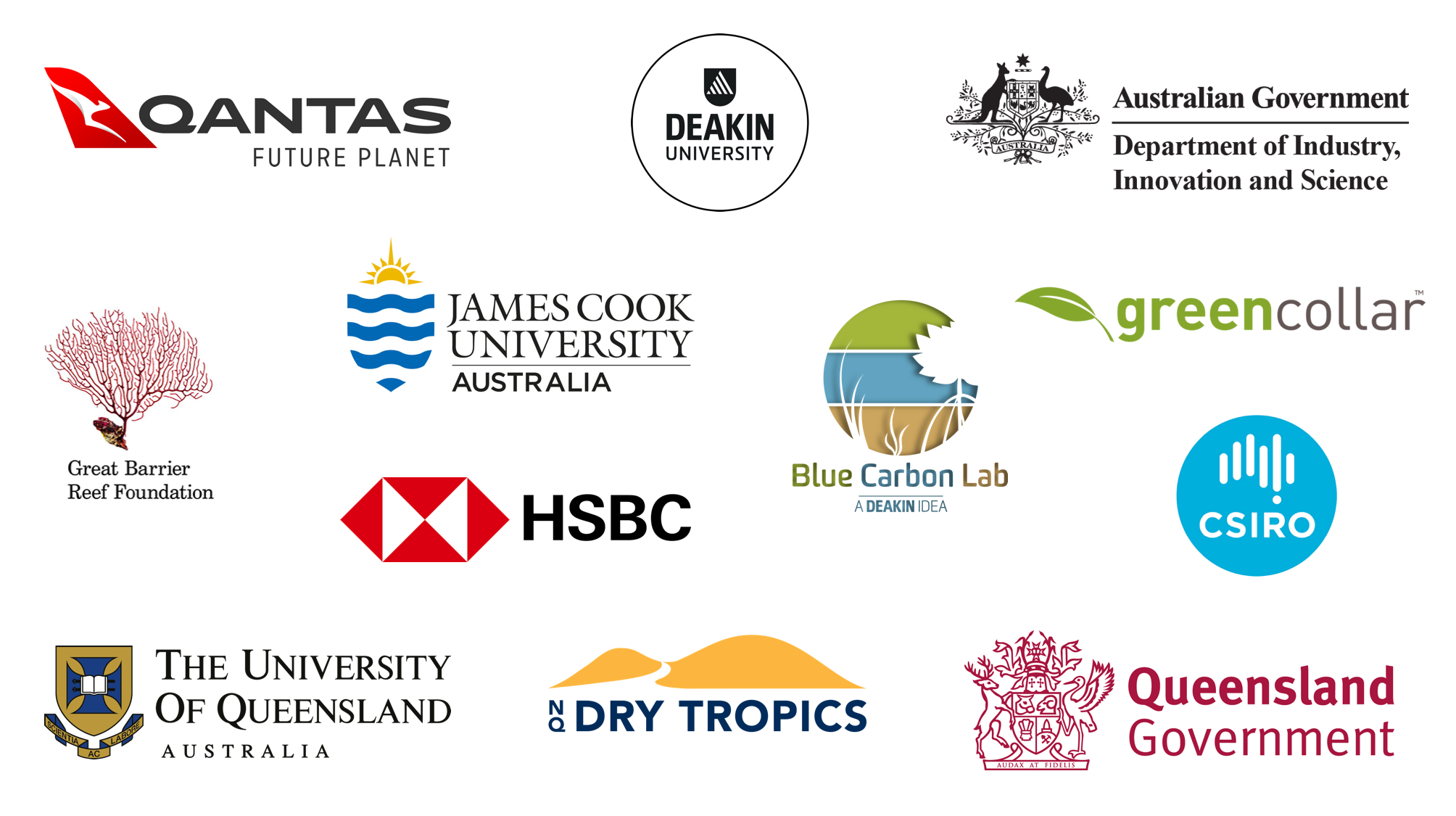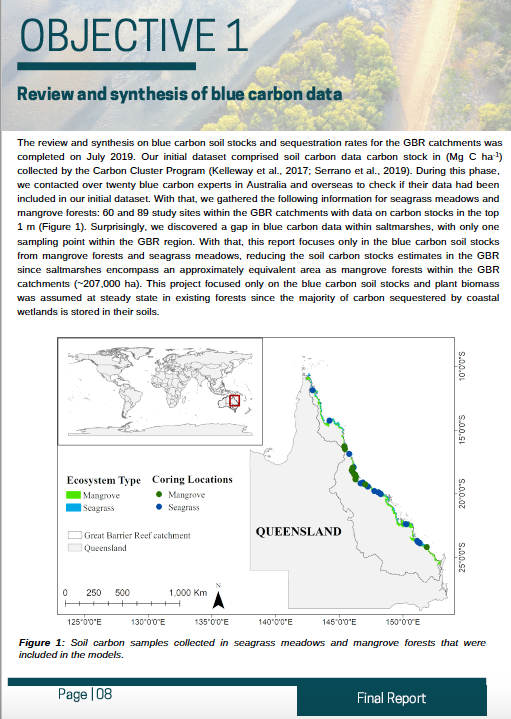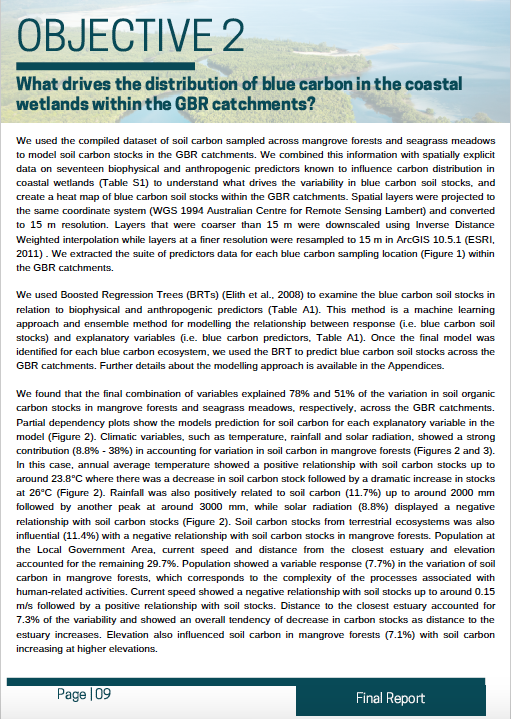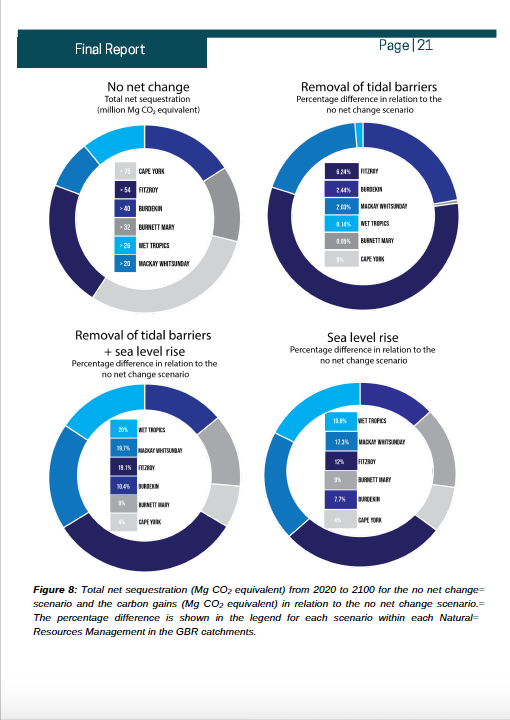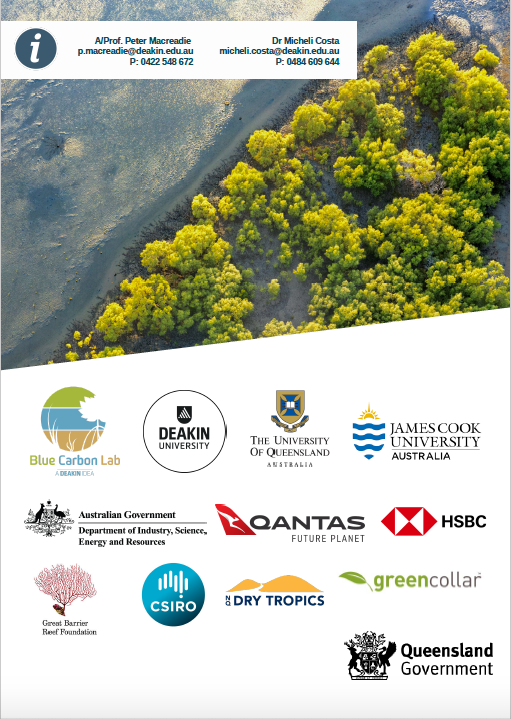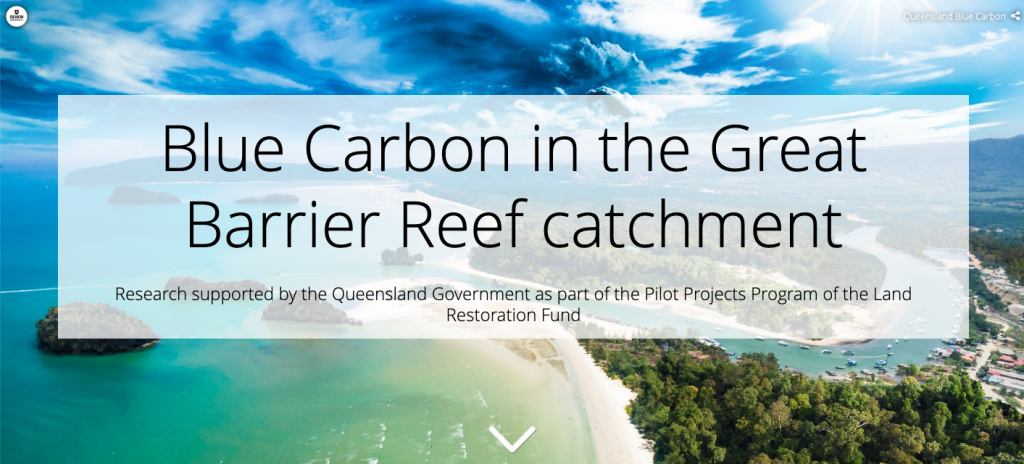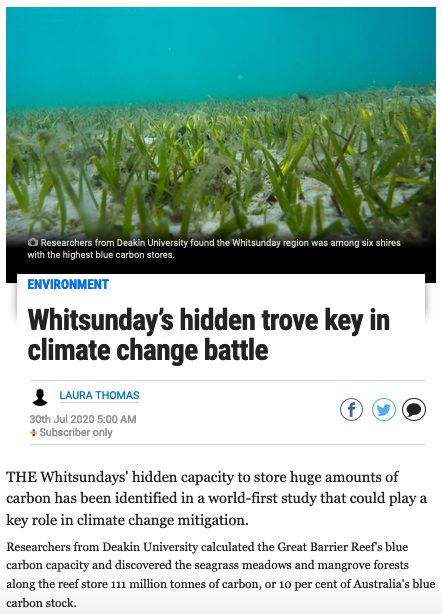QUEENSLAND BLUE
Queensland Blue
This program explores Queensland’s Blue Carbon potential, including mapping of Blue Carbon stocks and sequestration rates.
#QLDBlue is a multi-sector R&D collaboration – comprising Academia, Project Developers, and Industry – examining opportunities for Blue Carbon additionality in the Great Barrier Reef catchment.
This includes doing an inventory of QLD Blue Carbon Stocks and sequestration rates, analyzing drivers of Blue Carbon sequestration in QLD catchments, creating spatial heatmaps of sites suitable for Blue Carbon additionality, and developing predictive models of Blue Carbon under different management scenarios. Queensland Blue builds QLD’s Blue Carbon future and expands carbon farming through the development of a new Blue Carbon market.
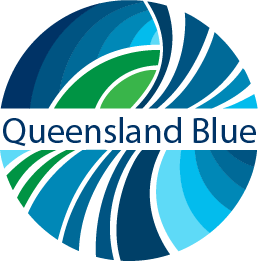
Program background
Blue carbon ecosystems (seagrass meadows, tidal marshes and mangrove forests) are among the most efficient carbon sinks, however, these ecosystems are declining globally. Because of their ability to capture CO2, there is an increasing recognition of their role in climate change mitigation, and consequently, a growing demand to incorporate blue carbon into national greenhouse gas accounts.
The Blue Carbon Lab will help put Queensland at the forefront of international efforts to incorporate coastal carbon within CO2 mitigation strategies, thereby helping to mitigate climate change while also improving other ecosystem services (e.g. water quality, enhancing natural capital, and contributing to jobs, economic growth and community wellbeing).
Queensland Blue answers the most critical question underpinning further consideration and investment in blue carbon in the Land Restoration Fund
context:
How big is the opportunity for blue carbon in Queensland and where to act?
Major findings
- Mangrove forests and seagrass meadows within the Great Barrier Reef catchments hold a blue carbon stock of over 111 million tonnes of carbon, which is equivalent to the annual emissions of ~87 million cars.
- These ecosystems would sequester ~251 million tonnes CO2 equivalent by 2100.
- Six Local Government Areas hold almost 70% of all the blue carbon in the Great Barrier Reef catchments. The top six blue carbon hotspots include the Cook Shire, Livingstone Shire, Gladstone Regional, Burdekin Shire, Isaac Regional and Whitsunday Regional.
- If considering the Natural Resource Management (NRM) regions, Cape York and Fitzroy regions hold more than 60% (~130 million tonnes of carbon) of the predicted carbon stocks.
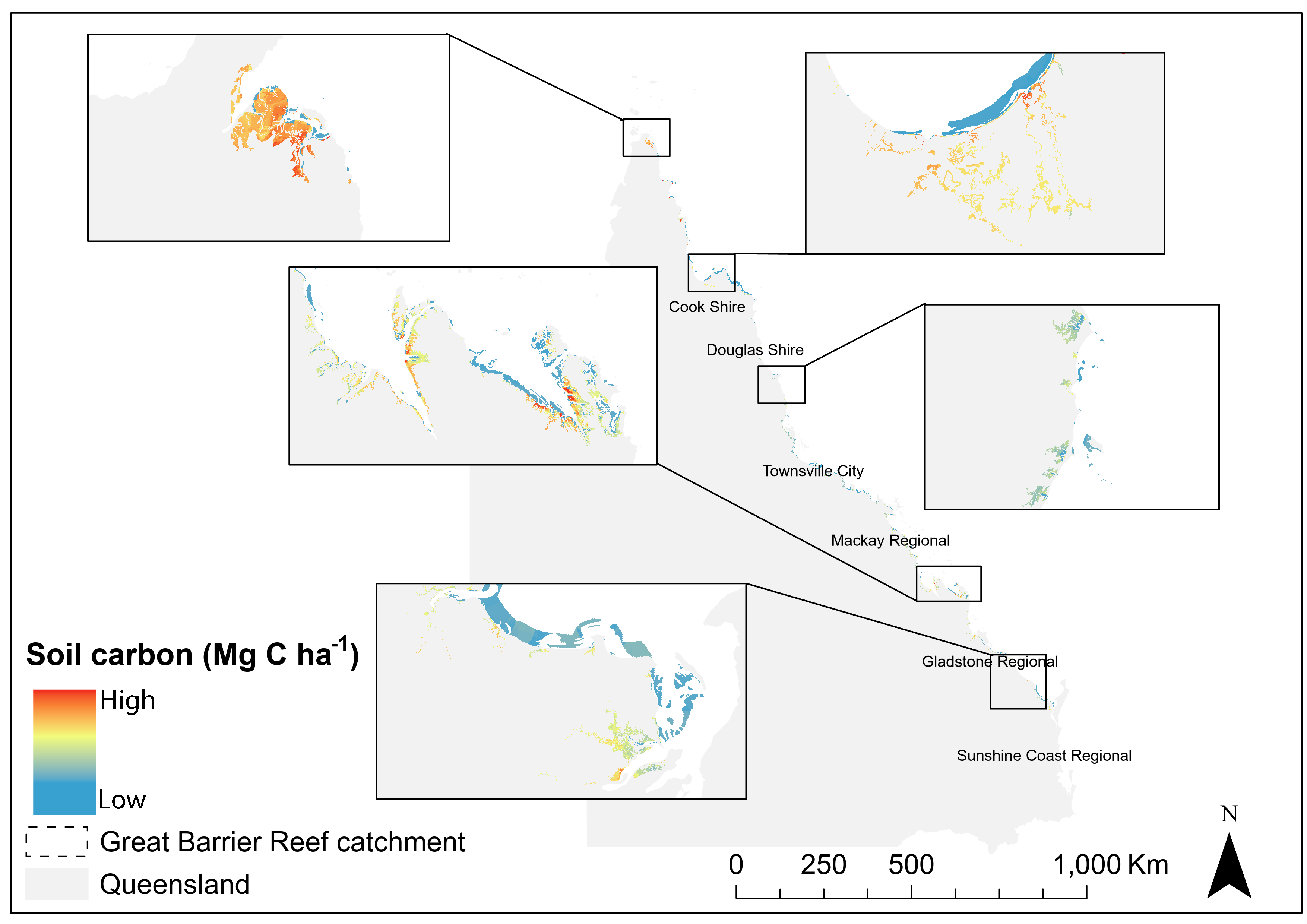
Media & Publications
Media:
- Impact story: Carbon treasure revealed at Great Barrier Reef. Deakin Impact, June 2021.
- Wetland increase has multiple benefits. Mirage News, May 2021.
- Carbon treasure revealed at Great Barrier Reef. Deakin disruptr, April 2021.
- Blue Carbon opportunities in Queensland’s Great Barrier Reef. ABC Far North Queensland – Breakfast, August 2020 (Interview at 2:39:30)
- Whitsunday’s hidden trove key in climate change battle. Mercury Mail, Whitsunday Times. July 2020.
- Carbon & Co-benefits webinar ‘Blue Carbon opportunities in Queensland’. Southern Gulf NRM. July 2020
- Great Barrier Reef has critical role in fight against global warming. Deakin Media release. July 2020
- HSBC and Qantas join Queensland’s Blue Carbon wave BCL Media Release. March 2020.
- Blue carbon potential in Queensland’s Great Barrier Reef. BCL Media Release. Feb 2020
- From sea to shining sink; carbon storing making waves. Diruptr. Jan 2020.
- Palaszczuk Government announces first six Land Restoration Fund projects. Queensland Government Media Statement. April 2019.
- New Grant: Blue Carbon potential in QLD. Media Release. April 2019.
Report / Publications:
- Duarte de Paula Costa, M., Adame, M. F., Bryant, C. V., Hill, J., Kelleway, J. J., Lovelock, C. E., Ola, A., Rasheed, M. A., Salinas, C., Serrano, O., Waltham, N., York, P. H., Young, M., Macreadie, P. (2023). Quantifying blue carbon stocks and the role of protected areas to conserve coastal wetlands. Science of the Total Environment, 874, 162518.
- Duarte de Paula Costa, M., Lovelock, C.E., Waltham, N.J., Moritsch, M.M., Butler, D., Power, T., Thomas, E. and Macreadie, P.I., 2022. Modelling blue carbon farming opportunities at different spatial scales. Journal of Environmental Management, 301, p.113813.
- Duarte de Paula Costa, M., Lovelock, C.E., Waltham, N.J., Young, M., Adame, M.F., Bryant, C.V., Butler, D., Green, D., Rasheed, M.A., Salinas, C. and Serrano, O., 2021. Current and future carbon stocks in coastal wetlands within the Great Barrier Reef catchments. Global Change Biology
- Costa MDPC, Lovelock C, Waltham N & Macreadie PI. 2020. ‘Blue Carbon Opportunities in Queensland: how much and where?’. A report provided to the Land Restoration Fund, Queensland Government. Deakin University, Melbourne, 34pp.
- Several scientific publications are currently being prepared.
Funding & Project partners
This project was delivered as part of the Pilot Projects Program of the Land Restoration Fund, supported by the Queensland Government.
Research was led by Deakin University in collaboration with The University of
Queensland, James Cook University, CSIRO, HSBC, Qantas, Australian Government Department of Industry, Innovation and Science, NQ Dry Tropics, the Great Barrier Reef Foundation and Greencollar.
